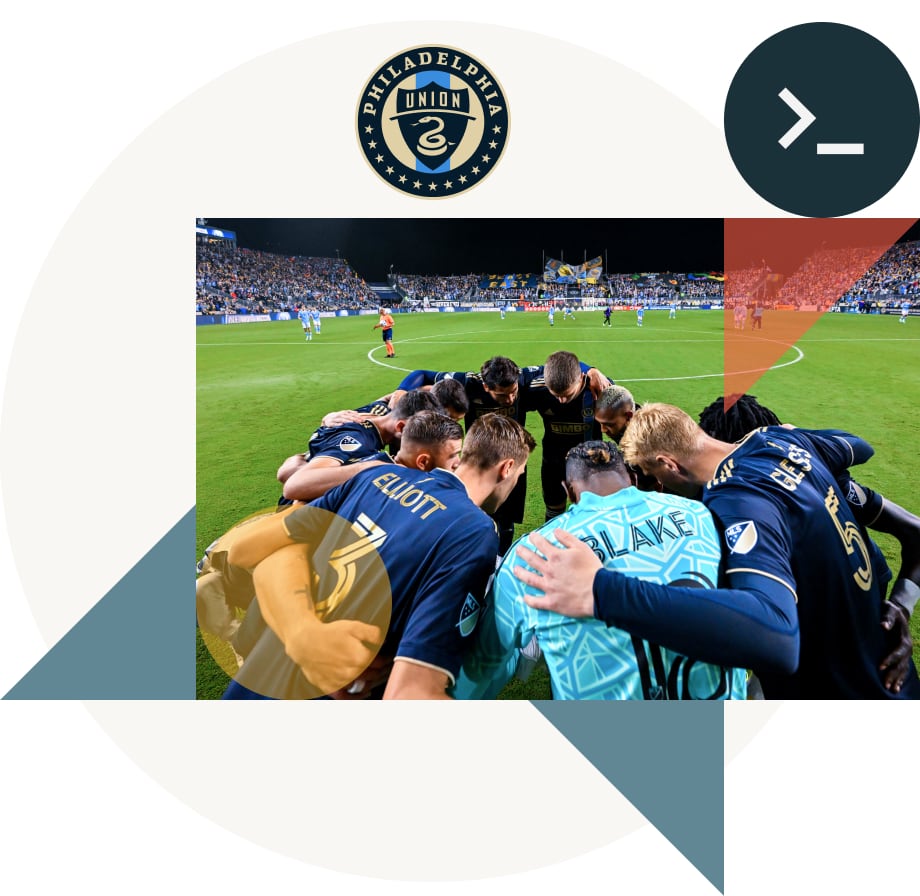Building a championship-caliber soccer organization
Reduction in time-to-insights that optimize player performance

In a city known for its sports culture, the Philadelphia Union of Major League Soccer have fast become a fan favorite, with 2.155 million viewers tuning in recently to watch them play in the MLS Cup. Part of the Union’s success can be attributed to their innovative use of analytics, from player recruitment to in-game analysis and opponent scouting, placing the team in the best possible position to win games and ensuring that they’re putting the best product on the field for their fans. But doing so was easier said than done, as siloed data sources housing terabytes of data capturing both historical and in-game player performance metrics — paired with highly manual processes and spreadsheets — stifled access to data and the sharing of insights. The need to implement a modern approach to data analytics led them to the Databricks Data Intelligence Platform. Now the Philadelphia Union are focused on building a championship culture that drives fandom with game-winning insights that feed the club’s decision-making on and off the field.
Lack of insight for improving player and team performance
From the use of advanced player metrics to the hyper-focused analysis of team tendencies, data and advanced analytics can reveal detailed performance cues that help organizations gain a winning edge. At the forefront of using data to improve the final outcome are the Philadelphia Union, with terabytes of structured and unstructured data from multiple third-party sources that capture in-game stats and player positional data by way of an optical tracking system. Using multiple cameras, the third-party data providers can track the location of every player and the ball at a rate of 25 frames per second. Another external data source collects physical data on over 50,000 players from around the world to compare players across clubs and leagues. By combining these data feeds with internal data about each player’s historical performance statistics, the Union are able to uncover opportunities to not only improve on-field performance but identify ways to prevent injuries. They also look to data and analytics for scouting and recruiting. Through their soccer academy, which attracts thousands of the top youth players in the country, they can look at performance metrics (speed, agility, endurance) over the development period of a player to understand strengths, weaknesses and how the player may fit within the team.
Prior to Databricks, the Philadelphia Union didn’t have a real data infrastructure in place to meet their needs. They were dependent on Excel spreadsheets to unify all this incredibly disparate data and perform necessary transformations. All this information was then stored in Microsoft OneDrive and on their analysts’ laptops and then fed to Tableau and Power BI for visualizations that their performance team would use to share insights with coaches. This process was completely manual and time-consuming, often taking 6 or more hours to generate a single report.
“Without a centralized data platform, all our exploration and data management was done on individual laptops,” said Addison Hunsicker, Data Analyst at Philadelphia Union. “We spent huge amounts of time working within spreadsheets to merge data and perform calculations. It was very tedious, time-consuming and error prone.” Understanding the competitive advantage that could be attained, they began their journey to modernize their data landscape and approach to analytics.

Using data analysis to change the game
With data unification, ACID compliance and faster time-to-insight being the primary requirements, the Philadelphia Union quickly settled on the lakehouse architecture without wasting effort looking at alternative solutions. “The ability to unify our data and analytics under a single platform in the cloud made the decision to deploy Databricks Data Intelligence Platform an easy one,” explained Joseph Trocchio, Director of Academy Performance at Philadelphia Union. “We felt that the lakehouse architecture was our means to becoming future-proof.”
Once the Philadelphia Union implemented the Databricks Data Intelligence Platform, the path to no longer needing multiple spreadsheets and long hours to perform analytics began. Databricks will provide the scalability and speed the data team requires to support the organization. Now they will be easily able to connect to their internal and third-party data sources to ingest and prepare terabytes of structured and unstructured data for rapid analytics and reporting.
“Running our player recruitment model, which is critical to building our team with the players that we need for our style of play, would take anywhere from 4 to 6 hours for each position, which equates to a week’s worth of work every time we need to run it,” said Hunsicker. “Now with lakehouse architecture, we will be able to generate these insights with the click of a button.”’
Game strategies and salary cap analysis on the horizon
With the Databricks Data Intelligence Platform serving as the core of their data strategy, the Philadelphia Union can reduce the time it takes to deliver new insights by 95%. This allows coaches and stakeholders to make smarter decisions that impact player and team performance, which has had a material impact on the team’s rise to being a consistent contender for the MLS Cup championship. For instance, with the timely delivery of post-match reporting through Tableau and Power BI dashboards, the data team can provide the coaching and training staff with a detailed analysis of how individual players and the team performed against an opponent, and what they need to focus on in future matches against the same or similar opponent. What used to take up to 5 hours to complete can now be done in minutes.

“Any insight we get can make a huge difference in the on-field product,” said Dean Costalas, Director of Soccer Analysis at Philadelphia Union. “Fortunately, our club recognizes the power of data to deliver these insights and there’s the organizational buy-in for what we’re doing from the top down. Our team leaders are believers in being at the forefront of innovation, and it’s paying off.”
Although they have started to make progress, the Philadelphia Union’s journey is only beginning as they look to advance beyond descriptive analytics to using predictive analytics to help with game planning, competitive scouting, and even contributing to the front office with salary cap analysis. With an assist from Databricks, the Philadelphia Union have cemented their position as a leader within the sports industry in leveraging data to build a championship-caliber organization.

